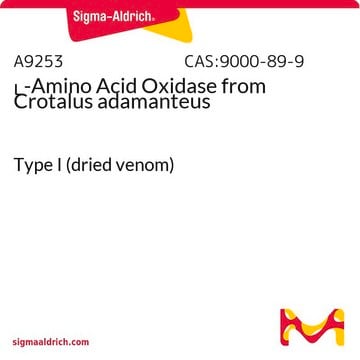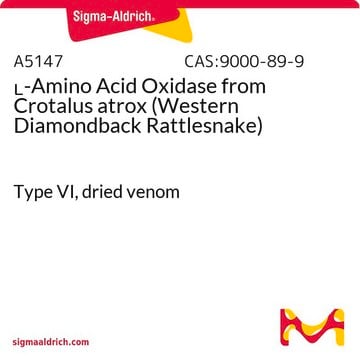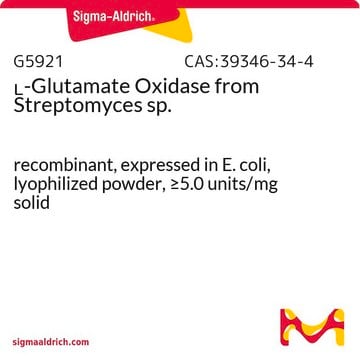A9378
L-Amino Acid Oxidase from Crotalus adamanteus
Type IV, ≥4.0 units/mg protein, aqueous suspension
Sinónimos:
L-AAO, L-Amino acid:oxygen oxidoreductase (deaminating)
About This Item
Productos recomendados
type
Type IV
form
aqueous suspension
specific activity
≥4.0 units/mg protein
mol wt
~130 kDa
contains
toluene as preservative
concentration
≥5.0 mg/mL
solubility
H2O: soluble 1.0 mg/mL, clear
storage temp.
2-8°C
Application
Biochem/physiol Actions
Packaging
Unit Definition
Preparation Note
signalword
Danger
hcodes
Hazard Classifications
Acute Tox. 1 Inhalation - Acute Tox. 2 Dermal - Acute Tox. 2 Oral
Storage Class
6.1A - Combustible acute toxic Cat. 1 and 2 / very toxic hazardous materials
wgk_germany
WGK 3
flash_point_f
Not applicable
flash_point_c
Not applicable
ppe
Eyeshields, Gloves, type N95 (US)
Certificados de análisis (COA)
Busque Certificados de análisis (COA) introduciendo el número de lote del producto. Los números de lote se encuentran en la etiqueta del producto después de las palabras «Lot» o «Batch»
¿Ya tiene este producto?
Encuentre la documentación para los productos que ha comprado recientemente en la Biblioteca de documentos.
Nuestro equipo de científicos tiene experiencia en todas las áreas de investigación: Ciencias de la vida, Ciencia de los materiales, Síntesis química, Cromatografía, Analítica y muchas otras.
Póngase en contacto con el Servicio técnico









